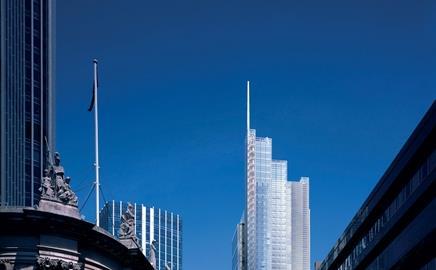Big buildings are rising up across London, putting pressure on suppliers and contractors alike
01 Introduction
Confidence in the commercial building market has contributed to a resurgence in the popularity of tall buildings in the UK.
This has been exacerbated by the 2012 Olympic Games, as companies want to showcase their businesses when the world’s eyes focus on the UK. The Shard, Heron Tower, the Pinnacle and the Boomerang are just some examples of projects due for completion in London before 2012.
The construction and procurement programmes for these projects started around the same time, and will follow a similar pattern. This has placed pressure on suppliers, who have been extending their forecast lead times.
Specialist contractors are experiencing full order books through to the last quarter of 2008, which is leading clients to review their procurement strategies. With fewer contractors available to provide competitive bids, projects are being forced to consider single sourcing to ensure they secure the resources they need ahead of the competition.
The shortage of supply will inevitably lead to cost increases, and clients that have not secured their preferred suppliers early may be forced to consider new suppliers with less experience in this market. Although this may address the lead-in problem, it will mean increased risk for the client.
Organisations that have invested in long-term relationships with their suppliers are in a stronger position than those that rely on the spot market for their services.
The wider picture within the money markets is already leading clients to review their current and future projects. The knock-on effect of this is unlikely to be seen in the order books of specialist contractors for a while. However, it may lead to these contractors being cautious about expanding to meet the forecast demand.
Understanding the pressures on these longer-term projects provides an insight into trends that will affect lead-in times in the commercial market over the next few years.
Steelwork, tower cranes, cladding and combined cooling, heat and power have already been identified as having extended lead-in times.
02 Steelwork
The complexity of the steel design of towers limits the number of companies that can bid for this type of work.
The current lead time for specialist steel construction on towers is about 26 weeks, compared with about 14 for traditional beam and column construction. The lead-in for this type of work is not only affected by capacity and resource availability but also the complexity of engineering design, planning and logistics.
Most larger projects have recognised this and have already identified their steel fabrication partners. The better informed clients are entering into pre-construction agreements to secure their preferred supplier and use its expertise to add value to the detailed steel design.
03 Tower cranes
Projects are already experiencing problems with the availability of tower cranes, and crane hire companies are forecasting that this will continue for the foreseeable future.
The lead-in for tower cranes was previously three months, but the current forecast is nine, with many companies reporting orders being placed with them through to 2010.
Most companies are recommending that clients speak to them as early as a year before work starts to secure their craneage requirements. Many projects are having to advise companies of their crane allocation requirements ahead of the quotation to ensure they are available for the project. This problem is not unique to the UK – mainland Europe is facing similar issues.
Luffing jib cranes are in particularly short supply, owing to the tower construction already planned. Crane hire companies are reporting similar lead in problems with smaller cranes.
With so much demand, the availability of cranes is restricted by the ability of crane makers to keep up with it. Other factors reported as affecting their availability are the development of wind farms and the impending London 2012 Olympics project, which contractors say will require as many as 200 cranes at the peak of construction.
03 Combined cooling, heat and power plant
Clients are becoming more attuned to the environmental impact of their buildings and, as a result, many are researching alternative solutions to their methods of reducing the carbon footprint of their buildings.
One option that is increasing in popularity is combined cooling, heat and power. The lead times for these large bespoke units has been quoted as high as 70 weeks, which reflects how few companies are able to produce this equipment.
04 Cladding
The cladding on UK tower projects is increasingly complex, as designers are striving to create more aesthetically pleasing envelopes for their buildings, complete with geometric and compound curved elevations.
This is already causing bottlenecks at the design phase as the industry struggles to recruit sufficient designers with the necessary experience. At this level of the market there are, again, only a limited number of specialist contractors that can do the work. The current reported lead-in has increased from eight months to 14. This is similar to the standard panel construction.
However, the peak in the workload is forecast to commence in between 18 months and two years’ time. Already, clients are being advised to book capacity with the contractors. Some contractors are reporting orders being placed for work in 2010.
Specialist contractors are reporting no major issues on the supply of more common materials. In fact, while cladding (including stainless steel, aluminium and glass) is probably one of the most visible aspects of a building, the cladding industry only accounts for a small proportion of the market for these materials. Therefore, it will be external market factors that will affect availability in future.




























No comments yet